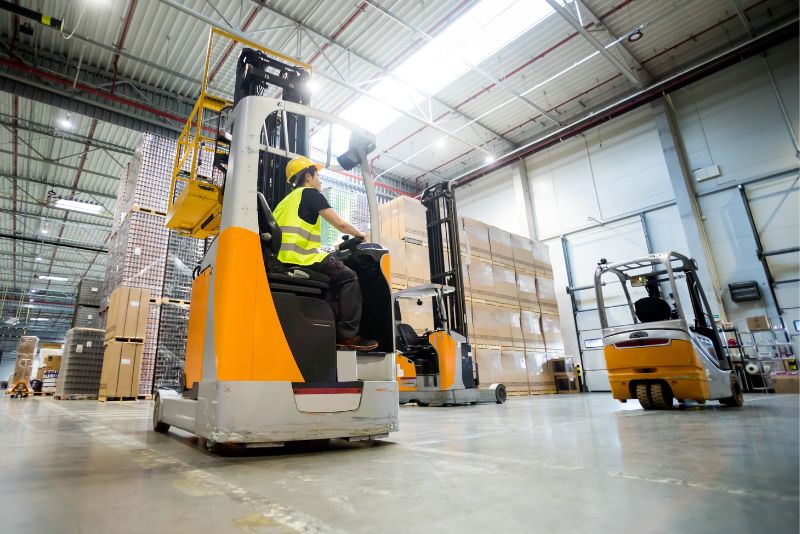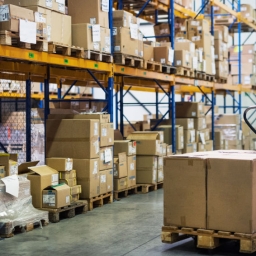
Material handling equipment refers to any tool that is designed to assist in moving materials short distances, such as in warehouses, manufacturing facilities, and distribution centres. Correct use of material handling equipment can significantly increase productivity and efficiency, reduce labour hours and the risk of product damage, and prevent worker injuries as a result of manual handling.
With so many different types of material handling equipment available, ranging from small hand-operated trucks to heavy machinery, it’s important to choose the right equipment for your facility in order to maximise safety and efficiency. Not sure what material handling equipment will work best for your needs? [talk to the experts at link-opp or] Read on for our quick guide to the different types of warehouse material handling equipment and their uses.
Industrial Trucks
Industrial trucks are used to lift and transport heavy objects and are commonly used in storage warehouses, manufacturing facilities, and distribution centres. Ranging from hand trucks and manual pallet jacks to large counterbalance forklifts, industrial trucks have a wide range of material handling applications and can be used to reduce labour hours and increase productivity.
Hand Trucks
Most people are familiar with hand trucks, also known as hand trolleys or dollies, commonly used by removalists and delivery drivers to transport small loads such as boxes and furniture. Hand trucks are built with an L-shaped metal design, including the flat base panel that sits against the floor and connects to the tall vertical frame of the hand truck.
The slim base panel of the hand truck makes it easy to slide beneath loads. Once in place, the hand truck is lowered onto its two wheels that sit behind the baseplate, allowing the loaded object to lean against the angled back of the frame to be easily rolled away.
Hand Pallet Jacks
Hand pallet jacks, also known as pallet trucks, are used to move larger, palletised items. A pallet jack is a simple machine built with two forks on which the pallet sits, similar to those of a standard forklift. The pallet jack is wheeled into place between the panels of the pallet using the handle. Once in place, the operator must pump the handle in order to lift the load off of the ground. By raising the pallet off of the floor, it is able to be easily pulled along, rolling on the wheels beneath.
Walkie Stackers
A walkie stacker is similar in design to a hand pallet jack, where pallets are loaded onto the two forks at the front of the truck with the operator standing behind at the handle. However, it is a motorised machine, reducing manual effort when lifting and moving pallets. Additionally, while pallet jacks can only be used to lit pallets just high enough to be rolled without touching the floor, walkie stackers can lift pallets up to the second shelf of a standard pallet racking system.
Sideloader
As the name suggests, a sideloader is designed to load and unload items from the side of the machine, with the lifting forks extending from the side rather than the front of the truck. The benefit of a sideloader is that products can be lifted and carried along an aisle without turning, making sideloaders suitable for use in aisles too narrow for a standard forklift. Plus, sideloaders offer increased visibility for the operator at the front and back of the vehicle as the load is held to the side.
Sideloaders are particularly useful for moving longer items as the length of the load points in the direction of travel, rather than sitting perpendicular to the truck as it would with a standard forklift.
Reach Trucks
A reach truck is built with the same wheelbase length as a standard forklift with a more compact body. Pallets loaded onto the forks of a reach truck are moved back and held partially within the wheelbase. This reduces how much of the load protrudes from the front of the truck, allowing reach trucks to be operated in narrower aisles.
Additionally, the operator of the reach truck sits sideways, allowing for the body of the lift truck to be more compact and providing more control for the operator when working in narrow aisles.
Counterbalance Forklifts
Counterbalance forklifts, often referred to as standard forklifts, are the most common type of forklift used. The tynes of a counterbalance forklift are located at the front of the truck and are used to lift and carry heavy loads. Counterbalance forklifts have a counterweight built into the truck to prevent it from becoming unbalanced or tipping when shifting heavy loads.
Counterbalance forklifts come in a wide range of lifting capacities, using larger counterweights for forklifts with higher lifting capacities in order to adequately offset the weight of the load.
Bulk Material Handling Equipment
Bulk material handling equipment is used to safely and efficiently move and store materials in bulk and is often used to transport loose products like coal, grain, or woodchips. There are many different types of bulk material handling equipment, including:
Stackers
A stacker is a large machine that is used to move bulk amounts of loose materials such as limestone, ores, and other granular materials into stockpiles. Commonly used in bulk material storage yards, stackers allow for the efficient organisation and storage of bulk materials until they are reclaimed.
Reclaimers
A reclaimer is another large machine that is used to recover stockpiled materials, using a rotating scoop to move materials from the stockpile to a conveyor system for transportation.
Silos
A silo is a cylindrical structure that is used for the bulk storage of loose, powdered, or granular materials such as coal, grain, silage, woodchips, and sawdust. Silos are commonly used in agricultural industries, allowing for large amounts of materials to be stored with a relatively small footprint by making use of vertical space.
Conveyor Belts
A conveyor belt is a motorised moving belt system on which materials can be placed to be transported from one end of the conveyor belt to the other. This allows materials to be automatically transported between different areas of the facility, reducing manual handling for increased safety and efficiency.
Bucket Elevators
Bucket elevators are similarly used to transport materials within a warehouse. However, bucket elevators are designed to transport bulk loose materials, such as grain, vertically. As the name suggests, bucket elevators are made up of a series of buckets connected to a belt or chain in which the materials are lifted upwards.
Storage Equipment
Storage equipment is used to store a wide range of goods, from loose materials to palletised items. Professionally designed storage equipment can significantly increase the storage capacity and organisation of any facility.
Stillages
A Stillage is essentially a large metal storage container, typically made with caged sides, that is used to separate and store loose goods off of the ground. Stillages are designed to be stackable for easy storage, with easy access gates from which stored items can be loaded and unloaded at ground level.
Industrial Shelving
Industrial shelving is a durable and versatile storage system that is typically used in handpicking warehouses and can be designed to store almost anything. Customisable in length, depth, height, and weight capacity, industrial shelving can be used to improve organisation, streamline order picking, and increase storage capacity.
Pallet Racking
Pallet racking is the ideal warehouse storage equipment for palletised goods. There are many different types of pallet racking systems, from high accessibility racks such as selective pallet racking to high-density systems like drive-in racking. There are also specialised racking systems available such as carpet racking, cable racking, tyre racking, and more.
Macrack offers quality industrial shelving and custom pallet racking systems designed for your warehouse and inventory to maximise storage capacity and streamline your warehouse processes. Talk to one of our racking experts today on 1800 048 821 for a free quote and warehouse design.



